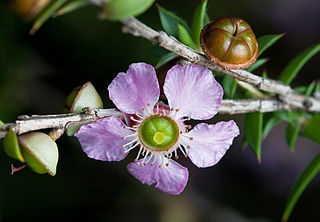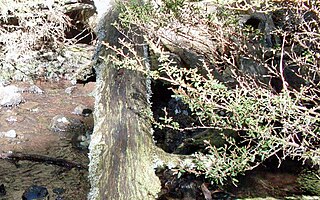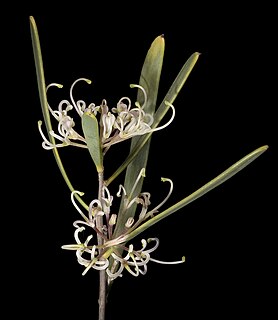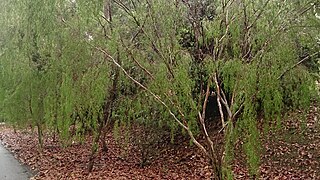
Leptospermum scoparium, commonly called mānuka, manuka, manuka myrtle, New Zealand teatree, broom tea-tree, or just tea tree, is a species of flowering plant in the myrtle family Myrtaceae, native to south-east Australia and New Zealand.

Leptospermum is a genus of shrubs and small trees in the myrtle family Myrtaceae commonly known as tea trees, although this name is sometimes also used for some species of Melaleuca. Most species are endemic to Australia, with the greatest diversity in the south of the continent, but some are native to other parts of the world, including New Zealand and Southeast Asia. Leptospermums all have five conspicuous petals and five groups of stamens which alternate with the petals. There is a single style in the centre of the flower and the fruit is a woody capsule.

Grevillea montis-cole is a shrub which is endemic to central-western Victoria, Australia. It has similarities in appearance to Grevillea microstegia, Grevillea floripendula and Grevillea aquifolium but has larger floral bracts. The flowers, which appear between October and March in its native range, have greenish to fawn perianths and red styles.

Sarcomelicope simplicifolia, commonly known as bauerella, hard aspen or yellow-wood, is a species of flowering plant in the family Rutaceae and is endemic to eastern Australia including Lord Howe and Norfolk Islands. It is a shrub or small tree with elliptic to egg-shaped leaves arranged in opposite pairs, male or female flowers arranged in small groups in leaf axils and fruit an oval to spherical drupe.

Leptospermum polygalifolium, commonly known as tantoon, jellybush or yellow tea tree, is a species of shrub or tree of the family Myrtaceae that is endemic to eastern Australia, including Lord Howe Island. It has thin bark, elliptical leaves, white flowers arranged singly on short side shoots and fruit that remain on the plant for a few years.

Persoonia myrtilloides, commonly known as myrtle geebung, is a plant in the family Proteaceae and is endemic to New South Wales. It is an erect to spreading shrub with elliptic to egg-shaped leaves and yellow flowers in groups of up to forty on a rachis up to 170 mm (6.7 in) long.

Leptospermum polygalifolium subsp. montanum known as the mountain tea tree or tantoon is a shrub or small tree found in eastern Australia. The original specimen was collected in 1912 near Yarrowitch. This plant is a sub-species of the Tantoon of the Myrtle family. It resembles other plants commonly referred to as "tea trees" or "paperbarks". The sub-species term montanum refers to its habitat of high altitudes. Polygalifolium is derived from Latin, referring to the resemblance of the leaves to certain members of the Polygala.
Trophis scandens subsp. megacarpa is a flowering plant in the mulberry family. The subspecific epithet comes from the Greek mega ("big") and carpos ("fruit"), with reference to the larger fruits in this subspecies.
Coprosma huttoniana is a flowering plant in the family Rubiaceae. The specific epithet honours Ian Hutton, the Lord Howe Island based naturalist who discovered the plant and recognised it as a new species.
Exocarpos homalocladus, commonly known as the grass tree, is a flowering plant in the sandalwood family. The specific epithet comes from the Greek homalos (“flat”) and clados, with reference to the structure of the plant.

Celtis conferta subsp. amblyphylla, commonly known as cotton wood or cotton-wood, is a flowering plant in the hemp and hackberry family.
Melicytus novae-zelandiae subsp. centurionis is a flowering plant in the family Violaceae. It is a subspecies of Melicytus novae-zelandiae, known in New Zealand as coastal mahoe. The subspecific epithet honours the military Captain James Doran McComish (1881–1948), who made several visits in the 1930s to collect plants on Lord Howe Island.

Olearia elliptica subsp. praetermissa is a flowering plant in the daisy family. The subspecific epithet means "overlooked", referring to the fact that this distinctive endemic subspecies was long overlooked.

Drypetes deplanchei subsp. affinis, commonly known as greybark or grey bark, is a flowering plant in the Putranjivaceae family. The subspecific epithet affinis alludes to its similarity to Drypetes sepiaria of India and Sri Lanka.
Passiflora herbertiana subsp. insulae-howei is a flowering plant in the passion flower family. The subspecific epithet refers to the island to which the subspecies is endemic.
Piper excelsum subsp. psittacorum, commonly known as pepper tree or kava, is a flowering plant in the family Piperaceae. The subspecific epithet means “of the parrots”, inferring a liking by parrots for the fruits.
Pouteria myrsinoides subsp. reticulata, commonly known as axe-handle wood, is a flowering plant in the sapodilla family, Sapotaceae. The subspecific epithet refers to the reticulate venation on the leaves.

Hakea stenophylla is a shrub or tree in the family Proteacea, with sweetly scented creamy-white flowers. It is endemic to Western Australia.

Leptospermum madidum is a species of shrub or small tree that is endemic to north-western Australia. It has weeping branches, smooth bark, pale green linear leaves, small white flowers and thin-walled fruit.

Leptospermum polygalifolium subsp. cismontanum, commonly known as tantoon, is a subspecies of flowering plant in the family Myrtaceae and is endemic to near-coastal areas of eastern Australia. It is a shrub or small tree with elliptical leaves and white flowers in spring.












